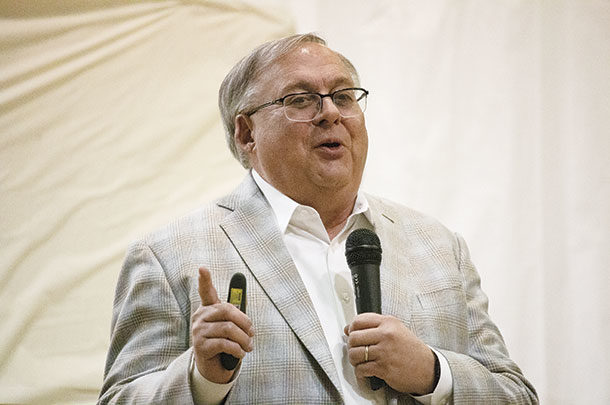That metric currently is what is keeping Robb, a senior economist with the Livestock Marketing Information Center, optimistic in a precarious protein market. Speaking at the Range Beef Cow Symposium at Mitchell, Nebraska, in November, Robb said domestic beef demand is now the stabilizing force as beef exports endure some trade hurdles.
“Consumption of beef is not demand,” Robb reminded his audience. “Demand is how much they ate and how much they are willing to pay for it. And the demand index for third quarter was 103. Even though they’ve eaten less than they did years ago, the price has compensated for it.”
U.S. consumption also includes a continuing chunk of imports of beef from Australia and cattle from Mexico. “The last three years, I’ve said beef imports will go down, and they haven’t. And the reason is the drought across Australia.”
Adding uncertainty are factors involving competing proteins. African fever roiled China’s pork production and fueled popularity of beef and pork. Trade issues with China have blocked the U.S. from sending pork and broiler volume to that country, and that leaves more supply here in the U.S.
“The broiler industry is growing faster than we thought,” Robb noted. “We don’t have a hope of this slowing down until fourth quarter of 2021.
“We’ve had to eat it here, and we haven’t had help. It’s at 80 cents a pound now, and it’s very competitive, and we’re producing more of it.
“We thought pork was going to play fair, and now they can produce 11 pigs per litter. We can’t export all that pork.”
On that issue, if trade issues can be lifted, it should help beef, Robb said.
“Next year, 2020 is a much better year for pork exports. They have such a great need for pork, they’re going to pay the tariff and bring it there.”
Consumption of competing protein is seen in per capita consumption figures, showing it was at 219 pounds in 2018, then went to 221 pounds in 2019 and is expected to rise to 224.9 pounds in 2020.
“We hope the economy keeps going forward and our consumers buy more beef because when the economy slows down, they trade down and buy more of this other stuff.”
The Tyson factor
Producers remain baffled, and angry, at what happened after the Tyson plant fire in Holcomb, Kansas, in August. The plant processes 5% of the country’s cattle, and its closure built frustration in the industry, with packers’ profits per head outpacing cow-calf producers by $200 to $300 in a six-week period.
Robb said market factors can explain why packers charged more. Restaurants overreacted and bid up the wholesale market overnight, he said. “That wasn’t the packer taking advantage of the market,” Robb said. “They’ve got to buy the product, and they’ve bought it on contract, but that’s the kink that moves in the market. And they got spooked.”
With 5% of the packing capacity removed, fed cattle prices began to dip with the logjam, and the packer margin expands. Calling it a “shock to the system,” Robb said the market jumped quickly to find a slaughter for rushed demand.
“The packer has to make a pile of money to get labor to come into work Saturday. The retailer panics, and so they bid more. The system came together, even though it was painful, where we ran a Saturday kill to process almost all those animals.”
But the markets didn’t explain those factors and paid a price with frustration from cow-calf producers and feeders, leading in part to the USDA probe into the markets that was announced in fall. On this point, Robb didn’t mince words.
“Tyson did a crappy job, a terrible job, of telling the story. They thought they were the center of the damn universe. They did an awful job of recognizing how it reverberated through the system.
“The reality is: If you want to tell the story, blame the retailers, then blame the packers, then blame people like me, then the media, then the hype. Tyson’s earnings were hit hard by this story. They had to restate their earnings.
“But I’m making the case the markets actually worked – as painful as it was, we got through it in a matter of months, instead of worse.”
Cull cow prices
Similar factors defined why cull cow prices have tanked, Robb said.
“The reason why cull cow prices are so low – we killed a huge number of dairy, and then beef cows, and if you kill that many you don’t have enough packers to do so. We just don’t have enough.”
If the U.S. can cut back on Australian beef imports, and dairies can keep milk prices high, the cull market could return to normal, he said. The calf crop from 2018 is smaller than the USDA previously forecast, so the supply could already be shrinking.
Robb said overall supply numbers could see reduction in the second half of 2020, with prices beginning to jump to $168 per hundredweight
on 500- to 600-pound steers and rising to $173 per hundredweight in 2021. ![]()
PHOTO: Jim Robb with the Livestock Marketing Information Center spoke at the Range Beef Cow Symposium in November. Photo by David Cooper.

-
David Cooper
- Managing Editor
- Progressive Cattle
- Email David Cooper









